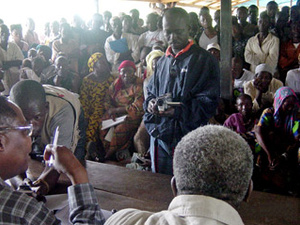Guinea: preparations for Parrot's Beak relocation
Guinea: preparations for Parrot's Beak relocation
A UNHCR team travelled to the isolated Parrot's Beak area Monday to prepare for the upcoming relocation of tens of thousands of Sierra Leonean refugees from the volatile border region to safer camps in the interior of Guinea.
Accompanied by Guinean officials, the team met refugee leaders at Kolomba, a large camp at the tip of the Parrot's Beak, a thumb of Guinean territory jutting into eastern Sierra Leone. The refugee leaders were told of plans for the relocation and of the need to move quickly while security and the weather permit. The rainy season is expected to begin shortly. The Parrot's Beak, where an estimated 80,000 refugees remain in a string of settlements and camps, has been cut off by fighting in south-western Guinea for much of the past seven months. Tens of thousands have already fled to the interior, many leaving on foot and later picked up by roving UNHCR patrols which then transferred them to new camps in the north.
The leaders at Kolomba were told that UNHCR may not have the trucking capacity to transport everyone out of the Parrot's Beak, and that many refugees may have to walk the first leg of the journey to a transfer site at Katkama, 50 km north of the south-western town of Guéckédou. From the farthest reaches of the Parrot's Beak, the foot journey to Katkama could cover some 60 km or more. Aid stations will be established along the way to provide rest, food and medical care. The most vulnerable refugees will be provided with transport to Katkama, from where all will be taken northwards by truck to new camps. Once the transfer is completed, UNHCR assistance to the insecure Parrot's Beak border region will be discontinued.
"We are seriously concerned about the situation of refugees who get cut off from humanitarian aid when there are attacks," said Ms. Pirjo Dupuy, UNHCR interim representative in Guinea. "Therefore, it is fundamental for UNHCR to bring refugees to safety where humanitarian aid can be delivered."
"We are seriously concerned about the situation of refugees who get cut off from humanitarian aid when there are attacks,"
Refugees in Kolomba had mixed feelings about the relocation. Most, however, appeared to accept the necessity of moving to safer areas away from the troubled border region. A delegation of 15 refugee women leaders from 12 camps expressed various concerns to the UNHCR team at Kolomba, including worries about educational opportunities for children; security for women during the walk northwards; freedom of movement and living conditions in the new camps; and long-term prospects for repatriation back to Sierra Leone.
UNHCR is working closely with Guinean authorities to finalise preparations for the relocation and could come up with a final plan this week. Since February, UNHCR has relocated some 30,000 refugees to two new sites in northern Kissidougou. A third site opened in central Guinea on Saturday. Boreah, the second settlement area, opened last week and now holds 3,500 transferred refugees trucked by UNHCR from Katkama and from Massakoundou camp in Kissidougou. In all, the new sites will have a total capacity of over 100,000.
Despite warnings from UNHCR and other others, several thousand refugees have also walked back to government-controlled areas in Sierra Leone, passing through dangerous border zones in a desperate attempt to flee tensions in the Parrot's Beak. Of those who reach government areas in Sierra Leone, some report ill treatment by armed groups throughout the journey.



